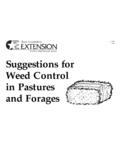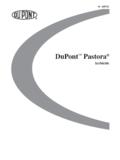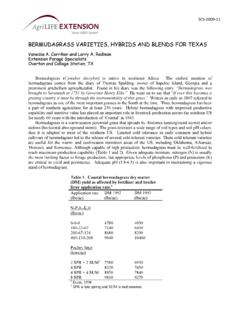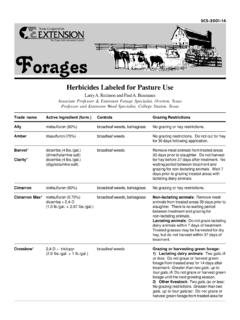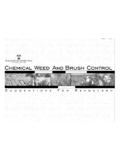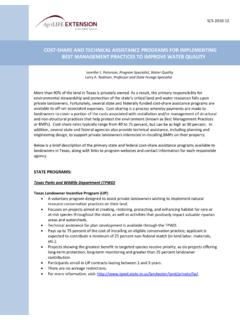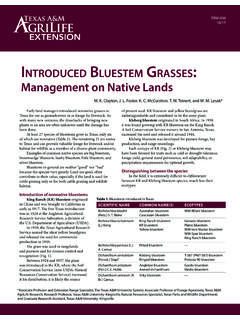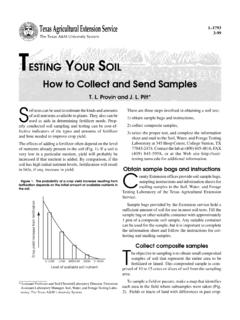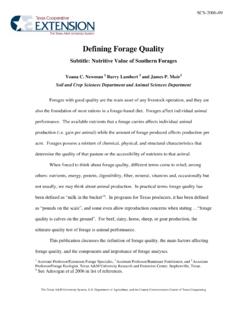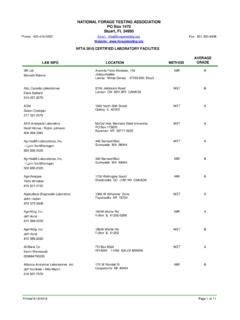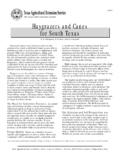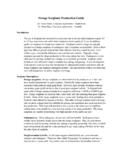Transcription of Six Year Forage Sorghum Summary - Texas A&M …
1 Summary of Six Years of Forage Sorghum Variety Trials Brent Bean and Ted McCollum1 Texas Cooperative Extension and Texas Agricultural Experiment Station A Summary of six years of Forage Sorghum variety trials is presented in Tables 1 and 2. Trials were conducted from 2000 to 2005 at the Texas Agricultural Experiment Station Bush Farm, located approximately 8 miles west of Amarillo. Only those varieties that were entered in the trials for at least three years are included. A Summary of the results along with the procedures used in conducting the trials for any given year can be found at Each year all varieties were planted on 30-inch raised beds at a seeding rate of 120,000 seed/acre.
2 Nitrogen and phosphorus application rates varied each year depending on soil tests results. The trials were considered fully irrigated with approximately 13 inches of total water applied during the growing season by furrow. Beginning in August, each variety was checked weekly for maturity. Once a variety reached the soft dough stage, the variety was marked for harvest that week. Harvest of early maturing varieties usually began in late August or the first of September. Late maturing varieties, including the photoperiod sensitive varieties, were usually harvested in mid-October. All Forage (silage) yields are reported at 65% moisture.
3 Nutrient analyses were conducted by Dairy One, in Ithaca, NY. Grain yield was collected from all grain producing varieties once plots reached physiological maturity. Results and Interpretation The Summary of six years of evaluations is shown in Tables 1 and 2. In both tables the first four columns provide identical information, including the number of years a variety has been tested, variety name, company that sells it, and description characteristics of the variety. More confidence should be placed in those varieties that have been tested for more years. Those varieties that are male-sterile were pollinated in the field by adjacent varieties.
4 Most companies will provide enough pollinator seed in the seed bag for sufficient pollination to occur to produce grain if requested. Table 1 presents plant height, moisture, and lodging scores at silage harvest, along with yield and nutrient analyses. The data presented are averages across years. Table 2 refers to data for each variety that has been indexed to corn. This was done by comparing each variety to corn (NC+ 7117) that was grown adjacent to the Sorghum plots each year . In years 2000 2003 the corn was fully irrigated, using significantly more water than was required to produce the Sorghum .
5 In years 2004 2005 the corn was irrigated exactly like the Sorghum . This resulted in a corn yield that averaged ton/ac compared to the 24 ton/ac 1 Extension Agronomist and Beef Cattle Specialist, respectively, Texas A&M Agricultural Research & Extension Center, Amarillo, phone: 806-677-5600, Email: and . The Texas A&M University System, Department of Agriculture, and the County Commissioners Courts of Texas Cooperating SCS-2006-04 2-06 average in 2000 2003. Because of this discrepancy in how the corn was produced, an average of the corn yield for 2000 2003 was used for comparison to Sorghum yields in 2004 and 2005.
6 Below is an example of how the calculations were made: Years of Evaluation 2002 2003 2004 Variety B yield, ton/Ac 20 22 24 Corn yield, ton/Ac 22 26 24* * avg. yield 00-03 Variety B yield (as a percentage of Corn production): 2002: 20/22 * 100 = 92% 2003: 22/26 * 100 = 85% 2004: 24/24 * 100 = 100% Average yield of variety B as a percentage of corn production over 3 years: This calculation was repeated for % crude protein, % ADF, % NDF, and % IVTD.
7 The lower the % ADF (acid detergent fiber) and % NDF (nutrient detergent fiber) the better the Forage is considered from an energy standpoint. Interpretation of the % IVTD (in vitro true digestibility) is just the opposite, with a higher number being desirable. Indexing each Sorghum variety to corn silage is appropriate since corn is considered the standard for the dairy industry. A variety with a %IVTD index value of 100% should be equal to corn silage as an energy source. In the last three columns of Table 2 the data was summarized based on selected performance criteria. In the first column those varieties with an average yield of at least 90% of fully irrigated corn or marked.
8 The second column is used to indicate those varieties with a % IVTD of 95% of corn silage. The third column shows those varieties that have an average % lodging score of 10% or less. Keep in mind that several factors will influence the degree of lodging that might occur with any particular variety. Lodging can be minimized by: Lowering seeding rate. Using a seeding rate of 60,000, rather than the 120,000 seeding rate used in this trial, should lower the potential for lodging. Do not over fertilize with N. Abundance of N will increase the potential for lodging. Harvest the silage as soon as the plants reach a moisture level of 68%.
9 With most varieties this will be when the grain reaches the soft dough stage. However, if it is observed that the lower leaves are drying out before the grain has reached soft dough stage, a sample should be collected and tested for moisture. Educational programs of Texas Cooperative Extension are open to all people without regard to race, color, sex, disability, religion, age or national origin The information given herein is for educational purposes only. Reference to commercial products or trade names is made with the understanding that no discrimination is intended and no endorsement by Texas Cooperative Extension and Texas Agricultural Experiment Station is implied.
10 Table 1. Actual averages across years of agronomic and nutrient anaylses of Forage Sorghum varieties. TCE and TAES, Amarillo, Yrs VarietyCompanyTypeMaturity BMRMale SterileHeight, Moist. @ LodgingSilage, Ton/Ac @ 65% Yield, lbs/AcCrude Protein, %ADF, %NDF, %IVTD, %32-Way F-103 Warner Seeds, Ever Green BMRW alter Moss SeedForage (check)NC+ HybridsGrain + 106 Seed ResourceForage BMRD russel BMRW alter Moss BMR 727 Sharp Brothers 8228 Crosbyton Seed Forage 9530 FCrosbyton Seed Forage SorghumML + HybridsForage IINC+ HybridsForage BMRR ichardson SeedsForage H-45 Golden HarvestForage H-47 Golden HarvestForage 6000 Frontier Seed 6500 Frontier Seed Master DRichardson SeedsForage N FeedCrosbyton SeedForage HeadlessSorghum 5-R BMRW arner Seeds, 9-R PSWarner Seeds, Graze 2000 Coffey Bee Warner Seeds, Bee Sterile IIWarner Seeds.
